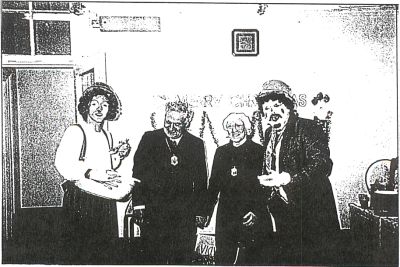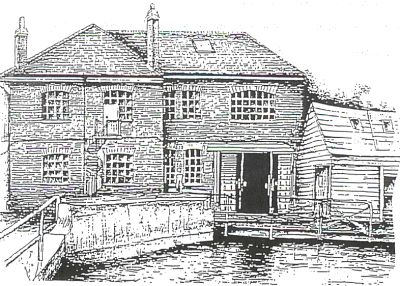A welcome from the membership secretary
As part of its program to persuade the Heritage Lottery Board to grant our application for the funds
we need to convert Ravensbury Mill, the Committee have been taking steps to strengthen the Board,
identify the necessary functions, and parcel out the work. The more business like we appear, the
better our chances.
As a "Newbie" on the Committee, my instincts for self preservation were sadly underdeveloped when
the appointment of a Membership Secretary was mooted. Nobody really knew what this entailed, but
everyone agreed this sounded a good idea. Who was going to be "It"? I was the one who did not duck
fast enough!
Having appointed me, the Committee felt it had done enough, and in a spirit of generosity, left it to
me to define my role. Since then I have been gathering information about the state of our membership,
and welcome the chance afforded by this News Letter to pass on some of what I have learnt.
We have, broadly, 5 categories of member:
1. The general membership: The broad base on which we rely. You all know who you are!
There are approximately 72 members, all paying the subscription of £8 [£12 for joint
membership]. The members keeps us going, and their support at fund raising events, as
well as their visits to the Museum provide a basis for our existence.
2. The Committee: The policy backbone of the Museum, and its driving force. Most
are members, although there are some who have. been co-opted for their expertise.
3. The Schools Membership: .The Schools are the members, rather than their staff or
pupils, and pay a flat fee. This category is particularly important, as it encourages local
schools to bring their pupils for demonstrations and lectures, and sows the seed for future
individual membership.
4. The Adminstrator and Volunteers: Not members as such, but the workhorses of the
Museum, without whom we could not function, ensuring that everything runs, and our
stalls are manned.
5. The "Brick Members": Again, not strictly members, but, having subscribed for a Brick
are included in our wider mailshots, and can be regarded as hot leads as prospective full
members from having shown that initial interest.
Many of you fall into more than one category, of course.
What this does illustrate, however, is the way the Museum relies on its members to operate. I feel it
is the function of the Membership Secretary to build on this. Our Museum Administrator will maintain
the registers of members, as always, and get out the mailshots, while the Members Sub Committee
will meet to discuss matters affecting the members (policy, subscriptions, Newsletters, events etc.).
My separate function is to act as the focus of the sub committee in generating and developing the
membership, which can fall into several categories:
1. Enlarging the membership; we must develop a package which encourages people to become
members, and, by the benefits they receive as members, remain as members. While it is
unlikely that the subscriptions we receive from members will ever be a significant source of
our funding, (as these are mostly eaten up by the costs of membership administation) a large
membership will help to create the momentum to drive us forward. A larger membership
also increases the chances of gifts and donations;
2. Involving the members; not only must our members be kept informed of everything that is
happening, but they represent a storehouse of knowledge, talent and energy that is in danger
of being wasted. A properly constructed database of the membership should reveal the skills,
expertise or knowledge of the individual members, as well as their geographical location, to
whom we can go for help in any given case. By way of example, we have been most lucky in
discovering, amongst the residents of Ravensbury Mill, a management accountant in Lisa
Connor, who has volunteered to serve on our committee as Finance Secretary, strengthening
us at exactly the time we need to show the Heritage Lottery Board the seriousness of our
intent and our ability to handle the substantially increased cash flow that a successful bid will
bring. This was a matter of good luck, however (she happened to be passing while we were
having the site meeting last autumn). Proper records and communication should reduce our
reliance on luck;
3. Attracting "Patrons" (by which I mean individuals or companies whose association with us,
by their status or wealth, will serve to promote the Museum). It is not a co-incidence that all
successful charities are able to put the names of high profile individuals on their letterhead,
or the names of big companies in sponsoring their activities. We need to recruit people in
positions of influence, who are able put the Museum's name forward whenever relevant.
4. Acting as the first point of call for individual members, as well as for Museum Administrator
when a Membership point arises.
To start the ball rolling, we will be sending out a revised membership form which I hope all of you will
try to complete and return. This will serve to update our records, and identify those of you willing to
be called on if we need help. It will also help us identify what you, as members, would like from, or for,
the Museum.
Later this year, when the opportunity arises, we will have a promotional event, probably linked to
Ravensbury Mill, and will let you have promotional material to distribute amongst your friends and
contacts linked to the event.
Despite my surprise at discovering myself as "It", I am committed to do the best I can with your help
and support. If I can help any of you in any way with Membership matters, please do not hesitate to
ring me (0181-542-7534/ fax 0181-543-3288).



